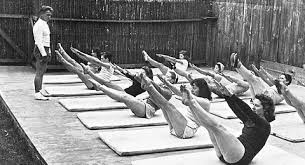To find your scoop, lie on your back with your knees bent and your feet flat on the floor, hip width apart. Lengthen the back of the neck so that your head is resting more towards the bottom of the skull. Allow the collar bones to soften and the shoulders to fall back to the floor and down away from the neck and ears. Breathe down into your belly with soft natural breaths. On your next exhale, draw the front of your ribcage together and down the front of your body towards your waist. Continue breathing gently into the belly.
Now, pull your transverse abdominis muscle (the abdominal muscle that is between your navel and your pubic bone) back into your body towards your spine. Keep your tailbone down as you do this, do not allow your pelvis to curl. Activate and release this muscle a few times until you feel comfortable doing so. Now add the "scoop". Pull your transverse abdominis muscle back towards your spine and then draw your navel up under your ribcage while keeping your ribs pulled together and down. Again, do not let your pelvis tuck or curl during this movement. Feel how your waist and muscles around your spine lengthen.
 |
| Joseph Pilates teaching at Jacob's Pillow |
Pay attention to your scoop the next time you are in class and see how activating in this way deepens all of your exercises!

















